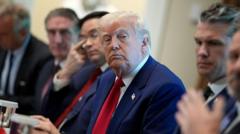White South Africans, particularly Afrikaners, are pursuing refuge in the U.S. as they claim to face backlash and violence in South Africa. Former President Trump’s policies have created a pathway for these migrants, stirring both support and controversy.
White South Africans Seek Refuge in the U.S. Amid Racial Tensions

White South Africans Seek Refuge in the U.S. Amid Racial Tensions
Thousands of Afrikaners are attempting to flee South Africa for the United States, citing safety concerns following the endorsement of refugee status by former President Trump.
From the moment Zenia Pretorius heard that then-President Trump had initiated an executive order to grant refugee status to white South Africans, it became clear to her and many others that departure from their homeland was imperative. Feeling increasingly endangered due to racial tensions, she found new hope as Trump and South African President Cyril Ramaphosa held discussions amplifying security concerns for Afrikaners.
During their meeting, Trump alleged that the Afrikaner community was facing farm seizures and violent attacks, although claims met resistance from Ramaphosa, who attempted to correct misinformation. Nonetheless, Trump produced disputed visual evidence, leading many such as Pretorius to interpret the U.S. leader as an ally. Pretorius recounted feelings of intimidation, detailing claims of threats and harassment they faced from Black settlers, reflecting her growing urgency to exit.
Despite South Africa's overall high rates of violent crime affecting various demographics, statistics indicate Afrikaners do not suffer from elevated victim rates compared to other South Africans. However, Trump's administration made a notable exception in refugee policy, exclusively targeting white South Africans and disadvantaged racial groups, thereby leaving behind Black citizens.
As the Trump administration opened borders, the first 59 Afrikaners migrated to the U.S. in May, with reports of thousands more seeking guidance on acquiring similar refugee status. Discrepancies in how these refugees are perceived and the administration’s rationale highlight the deepening complexities surrounding immigration, race, and safety on an international scale.




















